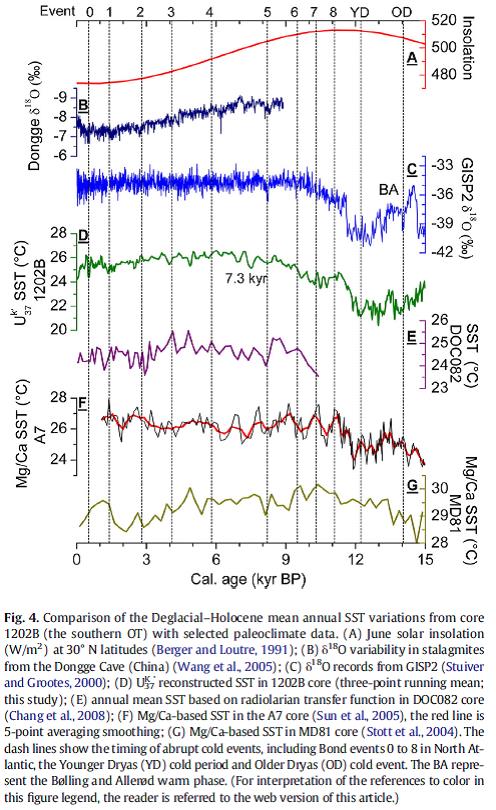Unsere Forschungsreise auf den Spuren der Sonne führt uns heute nach Ostasien. Von hier liegt eine umfangreiche Literatur zur klimatischen Wirkung solarer Aktivitätsschwankungen vor. Nahezu jede Woche kommt ein weiteres Paper hinzu. So konnte man zum Beispiel im Mai 2015 in Palaeo3 fündig werden. Eine Gruppe um Jiaping Ruan von der Universität Peking rekonstruierte im Ostchinesischen Meer mithilfe eines Sedimentbohrkerns die Meeresoberflächentemperaturen der letzten 15.000 Jahre. Dabei fällt eine ganze Serie von abrupten Abkühlungsphasen ins Auge, die jeweils 200 bis 1000 Jahre anhielten. Die meisten dieser Abkühlungsereignisse ereigneten sich interessanterweise zeitgleich mit Kaltphasen im Nordatlantik, die ein Team von Gerard Bond in einer wegweisenden Studie von 2001 dokumentierte und als Folge solarer Aktivitätsschwankungen interpretiert hatte. Hier die Kurzfassung der neuen Arbeit von Ruan und Kollegen:
A high resolution record of sea surface temperature in southern Okinawa Trough for the past 15,000 years
The study of long-chain alkenones in the Ocean Drilling Program (ODP) core 1202B reveals a sub-centennial resolution record of sea surface temperature (SST) in the southern Okinawa Trough for the past 15 thousand years (kyr). From the Deglaciation to Holocene, SST varied from 21.1 to 26.5 °C. The presence of Bølling (15.0–14.2 kyr BP) and Allerød (13.7–13.4 kyr BP) warming phases, Older Dryas (14.2–13.7 kyr BP) and Younger Dryas (12.8–11.6 kyr BP) cold periods reflects a tight teleconnection of climate between the Okinawa Trough and the North Atlantic region in the last Deglaciation. After rapidly increased and reached the maximum at ~ 7.4 kyr BP, SST in the southern OT gradually decreased, corresponding with the lowering of northern hemisphere summer solar insolation. However, a series of abrupt SST drops were identified at ca. 8.6–8.1, 5.8–4.8, 4.1–3.9, 3.0–2.5, 1.6–1.3 and 0.6–0.5 kyr BP, which cannot be explained by solar insolation changes alone, and instead are mediated by a complex sun–ocean–atmosphere coupling.
Im Haupttext gehen die Autoren weiter auf die beobachtete Bond-Zyklik ein:
SST in the Holocene […] is punctuated by a series of abrupt drops, each lasting 200 to 1000 years and centered at ca. 8.3, 7.3, 4.9, 4.0, 3.4, 2.5, 1.5 and 0.5 kyr BP. The cooling phases at 8.6–8.1, 5.8–4.8, 4.1–3.9, 1.6–1.3 and 0.6–0.5 kyr BP are synchronous with the well-established ice-rafting events in the North Atlantic (Bond Event; Fig. 4) (Bond et al., 1997), reflecting teleconnection between the OT and the high latitude northern Hemisphere. Other cooling phases at ~7.3, 3.4 and 2.5 kyr BP are not identified in the sediment record of the North Atlantic (Bond et al., 1997), suggesting influences from other factors such as variations in path and intensity of Kuroshio Current (Jian et al., 2000).

Abbildung 1: Die grüne Kurve (4D) zeigt den Temperaturverlauf des Ostchinesischen Meeres im Okinawa Trog während der vergangenen 15.000 Jahre. Die meisten Kältephasen fallen mit Abkühlungsereignissen im Nordatlantik zusammen (markiert mit gepunkteten senkrechte Linien, Nummerierung nach Bond et al. 2001). Quelle: Ruan et al. 2015.
Eine ähnliche Bond-Zyklik wurde auch von einer Gruppe um Jonathan Donges vom Potsdam Institut für Klimafolgenforschung (PIK) für den Asiatischen Monsun beschrieben. Die Arbeit erschien im Mai 2015 in Climate of the Past. Eine PIK-Pressemitteilung zur Studie gibt es leider nicht. In Tabelle 4 des Artikels wird explizit auf eine mögliche Auslösung der Bond-Zyklik durch Sonnenaktivitätsschwankungen eingegangen (Abbildung 2). Hier der Abstract der Arbeit:
Non-linear regime shifts in Holocene Asian monsoon variability: potential impacts on cultural change and migratory patterns
The Asian monsoon system is an important tipping element in Earth’s climate with a large impact on human societies in the past and present. In light of the potentially severe impacts of present and future anthropogenic climate change on Asian hydrology, it is vital to understand the forcing mechanisms of past climatic regime shifts in the Asian monsoon domain. Here we use novel recurrence network analysis techniques for detecting episodes with pronounced non-linear changes in Holocene Asian monsoon dynamics recorded in speleothems from caves distributed throughout the major branches of the Asian monsoon system. A newly developed multi-proxy methodology explicitly considers dating uncertainties with the COPRA (COnstructing Proxy Records from Age models) approach and allows for detection of continental-scale regime shifts in the complexity of monsoon dynamics. Several epochs are characterised by non-linear regime shifts in Asian monsoon variability, including the periods around 8.5–7.9, 5.7–5.0, 4.1–3.7, and 3.0–2.4 ka BP. The timing of these regime shifts is consistent with known episodes of Holocene rapid climate change (RCC) and high-latitude Bond events. Additionally, we observe a previously rarely reported non-linear regime shift around 7.3 ka BP, a timing that matches the typical 1.0–1.5 ky return intervals of Bond events. A detailed review of previously suggested links between Holocene climatic changes in the Asian monsoon domain and the archaeological record indicates that, in addition to previously considered longer-term changes in mean monsoon intensity and other climatic parameters, regime shifts in monsoon complexity might have played an important role as drivers of migration, pronounced cultural changes, and the collapse of ancient human societies.

Abbildung 2: Tabelle aus Donges et al. (2015) mit möglichem solaren Auslöser der Bond-Ereignisse.
Im Haupttext der Arbeit schlagen die Autoren weitere Forschungsanstrengungen vor, um die Rolle eines möglichen solaren Antriebs der gefundenen Klimazyklik besser zu verstehen und zu quantifizieren:
Considering statistical interdependencies between the records in this analysis, which could be due to common solar forcing and climatic interconnections in the Asian monsoon system, remains a task for future research.
Aufgrund der starken klimatischen Auswirkungen ist davon auszugehen, dass hier wohl Strahlungsantriebe für solare Schwankungen herauskommen werden, die deutlich oberhalb der im IPCC-Bericht angegebenen Spanne liegen.



